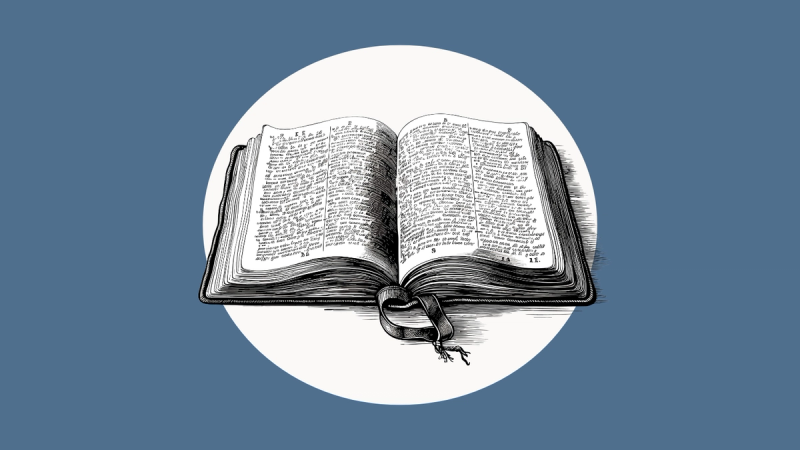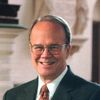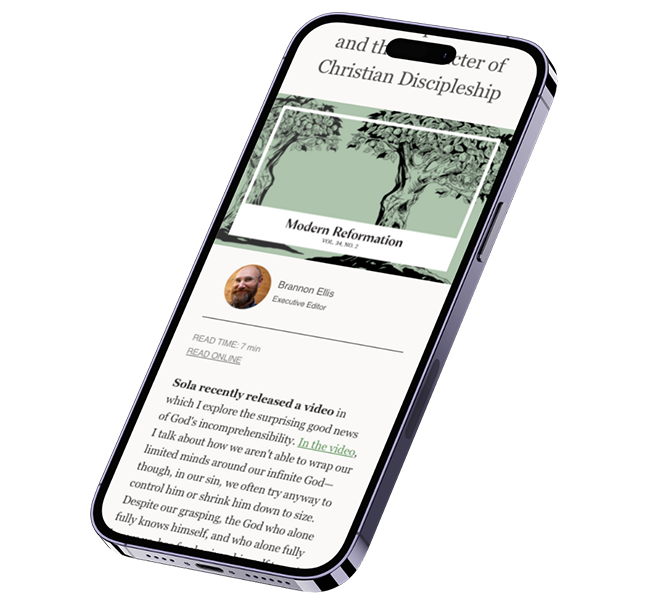Just as the Protestant reformation sought to restore doctrine and worship practice in accord with Scripture, so too a modern reformation must do the same. For a modern reformation to fully flower, there must not just be a return to biblical doctrine, but also a widespread Spirit-wrought renewal in biblical worship and discipleship. And thankfully, we have been given the divinely instituted pattern for this renewal on apostolic authority: “And they devoted themselves to the apostles’ teaching and the fellowship, to the breaking of bread and the prayers” (Acts 2:42).
From the church’s earliest days, this has been the paradigm. The church gathers as a body of believers to receive word and sacrament and respond in thanksgiving, prayer, and praise. This holistic reception of and participation in God’s salvific acts in time and space comes to us via the spoken and sacramental word—in mundane, tangible things like words spoken, water poured, bread and wine received. Here, heaven touches earth as the corporate body is swept up together into the great faith-creating mystery of Christ and him crucified.
It’s beautiful. It’s universal. It’s timeless. It’s just as relevant and conceivable in the twenty-first century as in the first century. It’s just as possible in a rural village as in a major city. It’s just as attainable in a new church plant as in a beautiful cathedral. It never runs dry. Our Lord’s pattern for Christian worship keeps on giving. It is his life-giving word and promise, overflowing in love to his people through his ordained means that shape and form us into his image as his disciples.
You know this. You need this. And, hopefully, this essay will remind you why you should want this too. It is your inheritance. It is your lifeblood. When the church gathers for worship, you are brought into the beating heart of the universe: the very life-giving center of the cosmos from which all things flow. This is where the world is set aright—and we are too. We are the people who gather around the true and living God who gives us his very life and love. Let’s not get side-tracked by our visions, plans, or pet projects that never fully satisfy us anyway. What if, instead, we focused on what the Lord gave us to focus on? Not only has Christ given us the clear biblical pattern, but the church throughout the ages testifies to the same: devotion to the apostles’ teaching, the breaking of the bread, and the prayers.
Writing in the 150s AD, Justin Martyr describes the structure of Christian worship in his apology to Emperor Antoninus Pius:
And on the day called Sunday, all who live in cities or in the country gather together to one place, and the memoirs of the apostles or the writings of the prophets are read, as long as time permits; then, when the reader has ceased, the president verbally instructs, and exhorts to the imitation of these good things. Then we all rise together and pray, and, as we before said, when our prayer is ended, bread and wine and water are brought, and the president in like manner offers prayers and thanksgivings, according to his ability, and the people assent, saying Amen.
In A History of Christian Worship, William Maxwell summarizes what we can glean about worship from Justin’s writings: “The balance was kept between the sacramental and Scriptural elements: both the reading of the Scriptures with instruction and the consecration and reception of the bread and wine were integral parts of the rite. Without either it was incomplete.” Kenneth Wieting similarly explains that “this is exactly how the Holy Spirit led the early church persistently to hold fast to Christ,” as the church “continually devoted herself to the teaching of the apostles, to the common participation in the Eucharist wherein the risen Christ was recognized, and to ‘the prayers,’ which framed the service of these gifts to the baptized.” Wieting adds that “this weekly devotion to the presence of Jesus by His gathered church continued down through the centuries” as the people of God received “the twin peaks of the Divine Service, first the word of Christ, then the meal of Christ.”
The main elements of Christian worship are present from the beginning. Basing our worship services on these apostolic elements not only clearly and faithfully delivers the gospel, but it actually is the process by which disciples are formed. Moreover, it insulates us in large part from the storms of worship wars and trend chasing. Reclaiming the apostolic pattern transcends the contemporary-traditional divide. It anchors us in Christ and where he deigns to meet us.
The Apostles’ Teaching: Hearing the Word
We encounter the first of the “twin peaks” of Christian worship in the word of God read and preached. A disciple heeds the word of his master. We gather to hear his holy word, to hear what the king has to say. And after hearing the king’s word read, it is explained and applied to the people. In what is much more than an academic lecture or motivational speech, the sermon is Christ speaking through the preacher. It is not just a word about God. It is a word from God. And that word from God does what it says. It kills and makes alive as the law thunders forth to impenitent sinners and the gospel comforts and heals the weak and heavy laden. It teaches, reproves, corrects, and trains us in righteousness (2 Tim. 3:16). Christian preaching is an encounter with the living God that, following the apostolic pattern, includes both gospel indicatives and sanctification imperatives based on what the biblical text being preached actually says.
We shouldn’t create a false dichotomy between announcing the gospel of God’s free forgiveness of all sins and exhortation to holy living in Christ. If the apostles did both, so can we. Read any sampling of sermons from the great preachers of the church throughout the ages and this becomes abundantly clear. As the living word does its work of dividing between soul and spirit, joints and marrow (Heb. 4:12), the table is being set. The food is being prepared and so are we. Which is why Christian worship since its earliest days has consistently included word and sacrament together. To end Sunday worship without the Lord’s Supper is like preparing a family meal together and then not eating it.
The Breaking of the Bread: Receiving the Sacrament
The second of the “twin peaks” of Christian worship is to partake of the Word enfleshed, for which we are prepared by hearing the word proclaimed. For most of church history, it would have been inconceivable and counterintuitive to depart from this historic pattern and separate the spoken word from the sacramental word. What if churches across denominations reclaimed the pattern of having the Lord’s Supper each week? What if our piety and practices were formed and shaped by the Christ of the Eucharist? This would be nothing short of revolutionary for our people. We would be brought further into a life of discipleship by participating in the life and pattern of Christ the crucified, being renewed and strengthened with this pure gospel gift of his own body and blood.
Reclaiming this practice is to embrace our ancient Christian and Reformation heritage, which highlights and upholds the union of word and sacrament in Christian worship. Maxwell reminds us of Luther’s view that Christian worship was “a weekly celebration of the Lord’s Supper, with sermon and communion.” He also summarizes Calvin’s position: “A minister’s task and office was not only to preach and instruct, but also to celebrate the Lord’s Supper every week, and to teach and urge the people to communicate weekly.”
The Prayers: Responding in Thanksgiving and Praise
Peppered throughout the twin peaks of Christian worship are liturgical prayers and songs of praise. These responsive elements have been vital components of Christian worship since the earliest days. In AD 112, Pliny the Younger reported on Christian activities to the Roman emperor Trajan. He wrote that the Christians were accustomed to meet “regularly before dawn on a fixed day to chant verses alternately amongst themselves in honour of Christ as if to a god.” The church has been chanting, singing, and praying the Aaronic Benediction, the Lord’s Prayer, the Kyrie, the Magnificat, the Benedictus, the Agnus Dei, the Gloria, the Sanctus, the Phos Hilaron, and countless other liturgical prayers and hymns “in honour of Christ” for millennia. Why cut ourselves off from such treasures? Why not let our voices unite with those who have gone before us?
Biblical Christian worship includes such responsive prayer and robust singing that is theologically rich and poetically pleasing. It complements the preached word and brings it to life for the people as their story and their song. This is another element of worship the Reformation helped to reclaim, as the language and grammar of the church’s liturgy, prayers, and songs disciples forms her disciples.
On the Day Called Sunday: Stepping into True Time
and the Eternal Day
In conclusion, I’d like to return to Justin Martyr’s letter to Antoninus Pius:
Sunday is the day on which we all hold our common assembly, because it is the first day on which God, having wrought a change in the darkness and matter, made the world; and Jesus Christ our Saviour on the same day rose from the dead. For He was crucified on the day before that of Saturn (Saturday); and on the day after that of Saturn, which is the day of the Sun, having appeared to His apostles and disciples, He taught them these things, which we have submitted to you also for your consideration.
Gathering for Sunday worship brings us into the eighth day, where we step into the eternal day of rest: the day of Christ’s resurrection and the ushering in of the new creation. Luther also picks up on this eighth-day symbolism.
The eighth day signifies the future life; for Christ rested in the sepulcher on the Sabbath, that is, during the entire seventh day, but rose again on the day which follows the Sabbath, which is the eighth day and the beginning of a new week, and after it no other day is counted. For through His death Christ brought to a close the weeks of time and on the eighth day entered into a different kind of life, in which days are no longer counted but there is one eternal day without the alternations of night. This has been thought out wisely, learnedly, and
piously, namely, that the eighth day is the eternal day. For the rising Christ is no longer subject to days, months, weeks, or any number of days; He is in a new and eternal life.
We enter into that “different kind of life” in worship as the pull of secular time with work schedules, school agendas, and sports calendars is overtaken by a true and deeper love and a true and deeper time—the fullness of time, as Paul calls it (Eph. 1:7–10; Gal. 4:4). The heavenly and earthly realms conjoin in Christ as the events of redemption established before the foundation of the world break into real time-and-space history in the mystery of the incarnation. And we are connected to this great mystery in the church.
James K. A. Smith reminds us that “our imaginations need to be restored, recalibrated, and realigned by an affective immersion in the story of God in Christ reconciling the world to himself.” The church’s worship life does exactly that, attuning us properly to the Christ-event, helping us see the deepest and truest reality of all things. Even before relativity suggested that time bends, the church already was practicing it. In some ineffably sacred sort of sacramental time travel, we participate in and are united to, as Paul says, Christ’s life, death, and resurrection. We were buried with him in baptism and are now dead to sin and alive to God (Rom. 6:3–11). We hear the very word of Christ that creates faith (Rom. 10:17). We experience a participation in Christ’s body and blood in the Eucharist (1 Cor. 10:16). Time is bending toward Christ at the font, at the rail, from the pulpit as Christ and him crucified becomes ours. “In worship we stand on the threshold between heaven and earth and participate in heaven’s liturgy,” William Cwirla writes. In our mysterious yet real participation in these divinely ordained means of grace we hear, feel, taste, and see that “the Word is present in all his creative and redemptive power: the baptismal water, the spoken Word of Christ, the bread and wine of the Supper.”
If we want a modern reformation, then we must remember that biblical worship is anchored in the apostles’ teaching, the breaking of the bread, and the prayers. Discipleship happens as we’re shaped by the teaching and table of our Lord, from which a Christ-formed life flows. As Jesus gives himself to us in preaching, sacrament, and prayer, our lives further imitate his. Our language becomes that of law and gospel, prayer and praise, creed and Trinity. We taste and see what is true, good, and beautiful, and the truth grows strong within our very bones. Biblical worship is a microcosm of what our lives are meant to be, reshaping our affections and transforming us from the inside out, making us disciples: worshipers of God and servants of one another. The cycle continues each week as we are pulled into the eternal rest of the eighth day in worship and then sent out into the world in our vocations. Christ is the liturgist, loving and giving himself to us. We then become liturgists to the world, loving and giving ourselves to our families, neighbors, and enemies. Christ gives us acts of mercy in worship; we give acts of mercy in the world.
The historic church plants its flag right here, and so should we. May the Lord make it so in our day.
Footnotes
Justin Martyr, First Apology, chapter LXVII, vol 1., in The Ante-Nicene Fathers, ed. Alexander Roberts and James Donaldson, (1885–1887; repr., Hendrickson, 1994), 185–86.
BackWilliam D. Maxwell, A History of Christian Worship: An Outline of Its Development and Forms (Baker, 1982), 13.
BackKenneth W. Wieting, “Sacramental Preaching: The Lord’s Supper,” in Preaching Is Worship: The Sermon in Context, eds. Paul J. Grime and Dean W. Nasady (Concordia, 2011), 78–79.
BackWilliam Maxwell writes, “The typical worship of the Church is to be found to this day in the union of the worship of the Synagogue and the sacramental experience of the Upper Room; and that union dates from New Testament times.” In A History of Christian Worship, 5.
BackFor a good treatment of how preaching should do both, see Heath Curtis, Telling People What to Think: A Concise Homiletics for Lutheran Parish Pastors (Reredos and Ambo, 2024).
BackWieting, “Sacramental Preaching,” 79.
BackMaxwell, A History of Christian Worship, 74.
BackMaxwell, A History of Christian Worship, 116.
BackPliny the Younger, The Letters of Younger Pliny, trans. Betty Radice (Penguin Books, 1963), 294.
BackJustin also develops this concept of the eighth day at several points in his Dialogue with Trypho.
BackMartin Luther, Luther’s Works, volume 3: Lectures on Genesis Chapters 15–20 (Concordia Publishing House, 1974), 140–41.
BackJames K. A. Smith, Imagining the Kingdom: How Worship Works (Baker Academic, 2013), 163.
BackFor a wonderful exploration of how the church has expressed “some kind of curvature of time, bending towards the One who was born to history ‘in the fullness of time’ and who is, at the same time before all things and the end of all things,” see James K. A. Smith, How to Inhabit Time: Understanding the Past, Facing the Future, Living Faithfully Now (Brazos, 2022), 76.
BackWilliam M. Cwirla, “Unfolding the Meaning of the Liturgy,” in Preaching is Worship, 144.
Back









